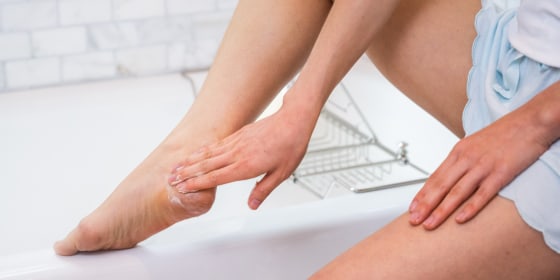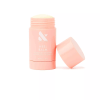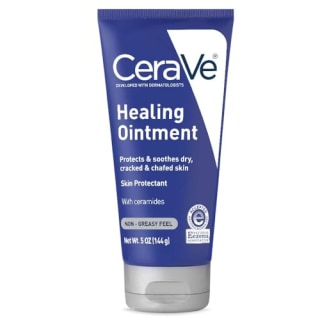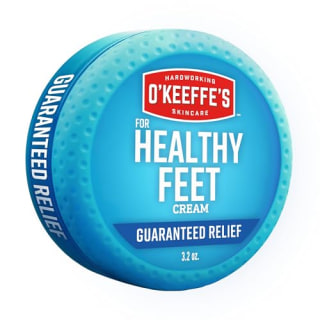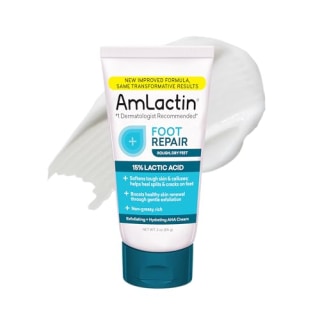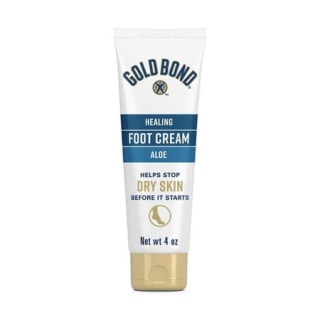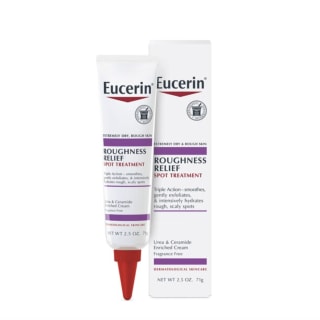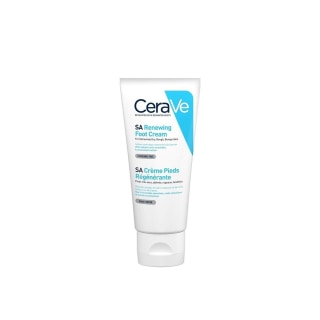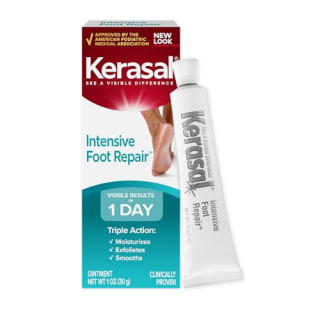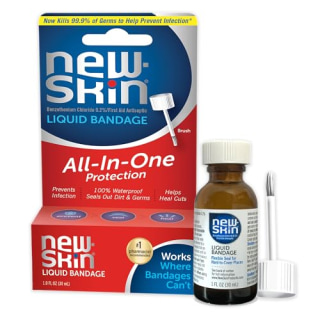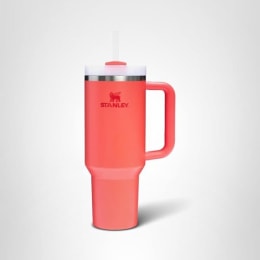Dry skin can affect every part of your body, down to uncomfortable cracks and deep, painful cuts or fissures in your feet. Though they can worsen in the wintertime due to lower humidity levels, board-certified dermatologist Dr. William Huang says several factors, including hot showers and harsh soaps, may contribute to dry heels year-round.
I spoke to five dermatologists about what causes dry, cracked heels and the best ways to treat them, plus highlighted their favorite treatments to shop.
How I picked the best treatments for dry, cracked heels
Experts say the key to treating fissures is to exfoliate, moisturize and avoid long, hot showers and harsh fragrances. Here is their guidance about what to consider when shopping for topical treatments:
- Ingredients: Look for moisturizing ingredients including petroleum jelly, glycerin, ceramides, hyaluronic acid and colloidal oatmeal, which can help restore your skin’s barrier and lock in moisture, according to our dermatologists. Avoid fragrances or harsh soaps — instead, opt for gentle, fragrance-free and moisturizing soaps and washes, and preferably non-foaming, liquid formulas that prevent your skin from drying out more.
- Exfoliants: Pay attention to exfoliants that help shed excess dry skin like ammonium lactate, salicylic acid, lactic acid and urea. However, avoid exfoliants if your heels’ cracks have caused open wounds since they can further irritate the skin.
Want more from NBC Select? Sign up for our newsletter, The Selection, and shop smarter.
Best treatments for dry, cracked heels
Below, I compiled dermatologist-recommended moisturizing and exfoliating products to help treat dry, cracked heels year-round.
Best ointment
This gentle, skin-repairing ointment is a favorite among the dermatologists I spoke to because it creates a barrier on your heels to seal in moisture and prevent infection. The formula has ceramides to restore your skin’s barrier and hydrating hyaluronic acid, according to the brand. The ointment has the National Eczema Association Seal of Acceptance, which means it’s suitable for sensitive skin.
Best foot cream
If ointments feel too thick on the skin, this thick foot cream from O’Keeffe’s is a favorite of Dr. Samer Jaber, a board-certified dermatologist at Washington Square Dermatology in New York City. The formula contains allantoin, a hydrating ingredient that penetrates thick, rough skin and creates a protective layer of moisture, according to the brand.
Best heel balm
Olive & June is a favorite brand among NBC Select editors, and this overnight treatment is a quick and convenient way to get relief. The balm comes in a stick form that you rub on your heels directly, so you don’t have to apply your foot cream with your hands or squeeze it out of a tube. Roll on the balm once a week as a nighttime foot treatment and wear socks afterward to lock in moisture, according to the brand.
Best foot mask
This Aveeno foot mask comes recommended by Dr. Nkem Ugonabo, a board-certified dermatologist at Union Derm in New York City. It’s shaped like a slipper, so you can easily slip it on and off, plus, it includes a fastening strap to keep it in place. The fragrance-free formula contains shea butter and prebiotic oat, both expert-recommended ingredients that help moisturize the skin. The brand recommends leaving the foot mask on for 10 minutes, and you don’t have to rinse off your feet afterward, according to Aveeno.
Best for sensitive skin
“This ointment contains petrolatum and glycerin, which work together to hydrate and protect dry, cracked skin,” says Dr. Annie Chiu, a board-certified cosmetic and general dermatologist and founder of The Derm Institute in California. Formulated for sensitive skin, you can use this preservative- and fragrance-free ointment as a foot cream, lip moisturizer, hand cream, minor wound treatment and more.
Best exfoliating
Huang recommends this Amlactin cream, which has 15% lactic acid that gently exfoliates and removes dead skin cells. In addition to smoothing out dry, flaky skin, this fragrance-free cream softens calluses and improves splitting and cracking heels, according to the brand. You can apply this cream twice a day — remember that it has exfoliating alpha hydroxy acids (AHAs), like lactic acid, which means it can increase sun sensitivity, experts say.
Best soothing
This Gold Bond cream has a blend of moisturizing vitamins, including vitamins C and E, plus aloe vera to soothe irritated, cracked skin, says Chiu. The foot cream locks in up to 24 hours of moisture and is fragrance-free and non-greasy, according to the brand.
Best for roughness
This spot treatment has a high concentration of urea (30%) to exfoliate the skin, plus ceramides that provide a good amount of moisture, says Dr. Barry Goldman, a board-certified dermatologist and founder of Goldman Dermatology in New York City. According to Eucerin, it also contains lactic acid, which works in conjunction with the urea to remove dead skin cells.
Best with salicylic acid
Goldman recommends this foot cream to his clients because it has salicylic acid to loosen dead skin and hyaluronic acid to retain moisture. The cream absorbs quickly into the skin, is non-greasy and helps reduce roughness or cracks on feet, according to the brand. It also has the NEA Seal of Acceptance for sensitive skin. You can use this cream daily, but wear an SPF on top of it since the AHAs in the formula can increase sun sensitivity, according to the brand.
Best for intense dryness
This Kerasal ointment is a favorite of both Chiu and Jaber. It has salicylic acid and urea, which work together to exfoliate and soften rough, dry skin on the heels, says Chiu. By loosening dead cells, moisturizing ingredients like petrolatum can better penetrate the skin, according to the brand. The foot cream is also approved by the American Podiatric Medical Association, which means it was reviewed by a group of podiatrists to make sure it’s effective for dry, cracked heels.
Best liquid bandage
“If you have painful cracks in your feet, a liquid bandaid can be very helpful to reduce the pain and allow the area to heal,” says Jaber. He recommends these liquid bandages from New-Skin, which create a tough barrier on cracks and cuts to prevent infection and speed up healing. The bandages are water-resistant and flexible and dry clear so they can match your skin tone, according to the brand.
What causes dry, cracked heels?
Dry, cracked heels are very common and can occur at any time of the year. Below, our experts highlight a few main causes of dry, cracked heels:
- Lack of moisture: The primary cause of dry, cracked heels is a lack of moisture or a damaged skin barrier, according to our experts. “When the skin on the heels becomes too dry, it can crack and split,” says Chiu. Low-humidity environments and prolonged hot showers can cause this.
- Standing or walking for long periods of time: This creates pressure on your feet that can cause the skin to dry out and crack.
- Medical and skin conditions: Eczema, diabetes, psoriasis and athlete’s foot are conditions that increase the likelihood of dry, cracked heels. Increased weight and added pressure on the heel can also lead to dry skin in the area, says Huang.
- Wearing open-back shoes: If your shoes expose your heels, you increase the risk of them becoming dry and cracked. Shoes that are too tight can also cause heel spurs, according to Goldman.
- Using harsh, fragrant soaps and ingredients: “Harsh soaps can break down your natural skin barrier, so switch to a non-fragranced, moisturizing liquid cleanser to help,” says Huang.
- Age can make your skin, including the skin on your feet, thinner, less elastic and drier over time because it produces less natural oils, says Jaber.
How to treat dry, cracked heels
When it comes to dry heels, prevention is key. When the weather gets colder, a humidifier in your room may help, says Huang. Instead of long, hot showers, which can dry out your skin more, opt for short, warm showers or baths. Plus, use fragrance-free moisturizing products that can help repair your skin’s moisture barrier. Our experts note a few tips below to keep in mind.
Keep your feet clean and moisturized
To help treat dry, cracked heels, wash your feet with non-foaming hydrating cleansers (preferably with a cream or milk consistency) to prevent skin drying. After your bath or shower, you should apply a moisturizer immediately to help retain some of the water on your skin; you should moisturize your heels at least twice a day, says Goldman.
Huang recommends using products with moisturizing ingredients like glycerin, ceramides, hyaluronic acid and colloidal oatmeal to help lock in moisture. For relieving pain and inflammation, Chiu recommends aloe vera — a natural anti-inflammatory that soothes dry, cracked skin — and vitamin E, an antioxidant that promotes healthy cell growth and protects the skin from damage.
After moisturizing and exfoliating (more on that below), apply a thick, occlusive emollient like petroleum jelly to lock in moisture. “I recommend applying right before bed and under cotton socks,” says Ugonabo. You can lock in moisture with breathable socks made from either natural cotton or wool, which are usually less irritating than synthetic materials, says Jaber.
Slough off dead skin
Our experts say to get rid of dead skin, soak your feet in warm water for 15 minutes and gently scrub with a loofah, pumice stone or foot file. “This will help remove dead skin cells and make it easier for moisturizers to penetrate the skin,” says Chiu. Follow that with moisturizers that have exfoliating ingredients like ammonium lactate, salicylic acid, and urea, says Huang.
Seal deep cracks
“Liquid bandages can be very helpful to seal up cracks,” says Ugonabo. They can also ease the pain of walking on torn skin while keeping the wounds clean.
Meet our experts
At NBC Select, we work with experts with specialized knowledge and authority based on relevant training and/or experience. We also ensure that all expert advice and recommendations are made independently and with no undisclosed financial conflicts of interest.
- Dr. William Huang is a board-certified dermatologist and adjunct professor at Duke University’s department of dermatology.
- Dr. Samer Jaber is a board-certified dermatologist at Washington Square Dermatology in New York City.
- Dr. Annie Chiu is a board-certified cosmetic and general dermatologist and founder of The Derm Institute in North Redondo Beach, California.
- Dr. Barry Goldman is a board-certified dermatologist and founder of Goldman Dermatology in New York City.
- Dr. Nkem Ugonabo is a board-certified dermatologist at Union Derm in New York City.
Why trust NBC Select?
I am an updates editor at NBC Select who has covered various skin care topics, including products for rosacea, keratosis pilaris and cystic acne. For this article, I spoke to five dermatologists to narrow down the best treatments for dry, cracked heels, and highlighted their recommendations for the best products to consider.
Catch up on NBC Select’s in-depth coverage of tech and tools, wellness and more, and follow us on Facebook, Instagram, Twitter and TikTok to stay up to date.

